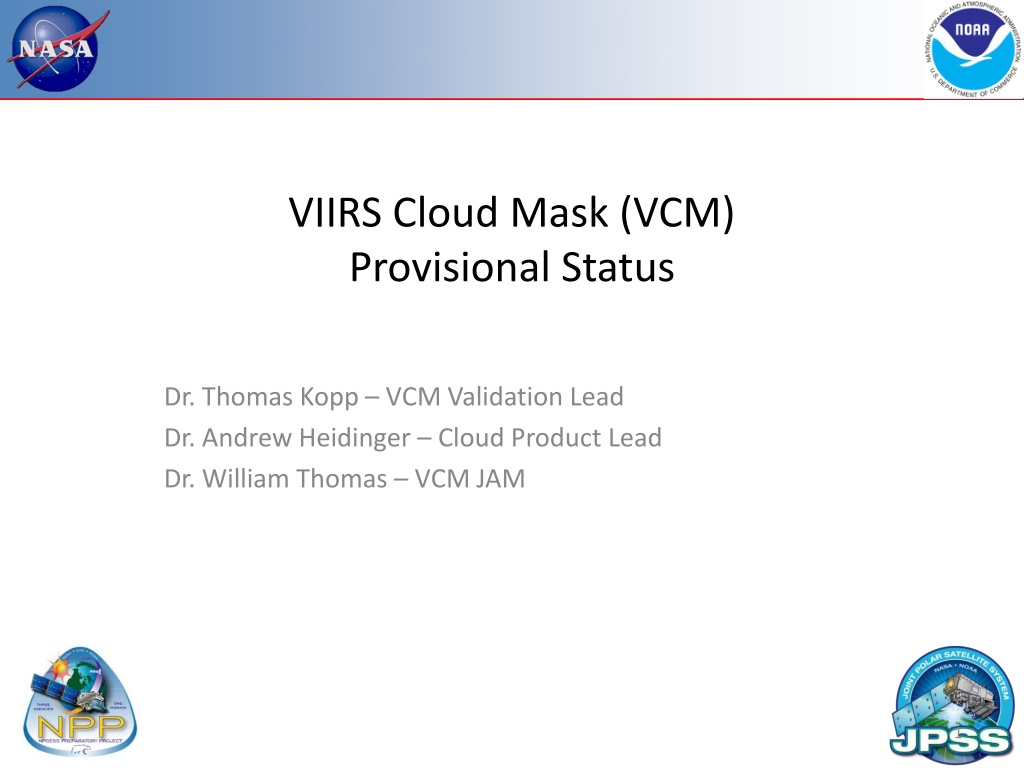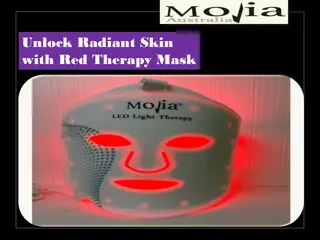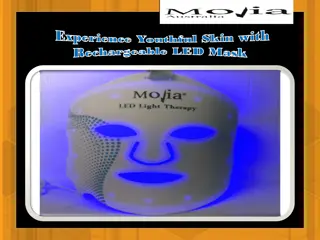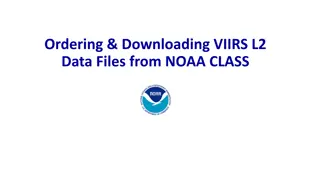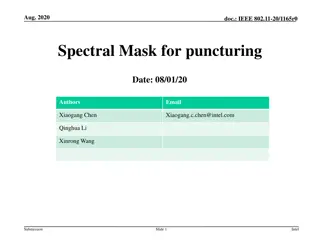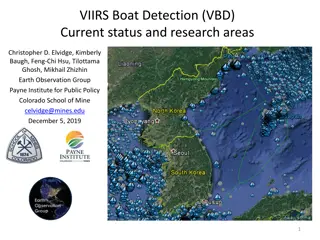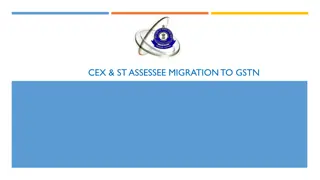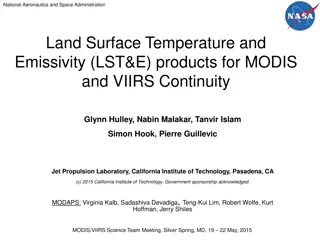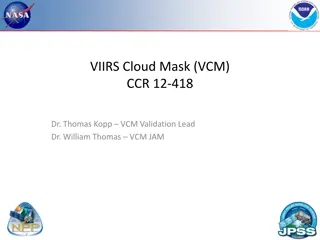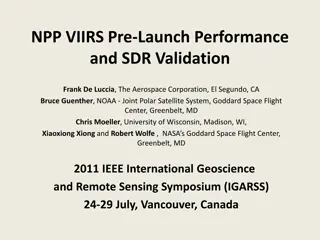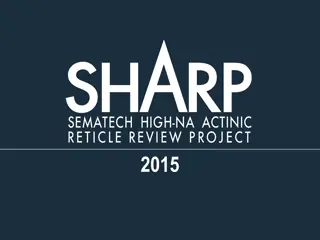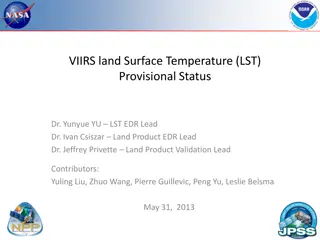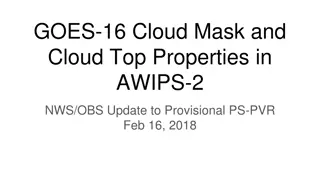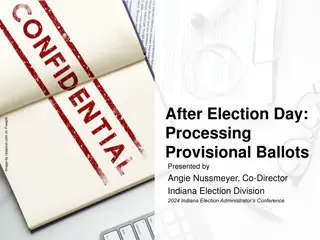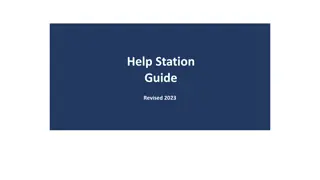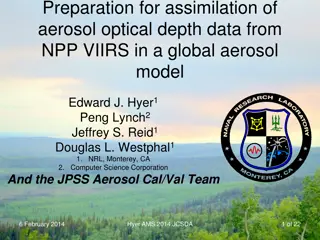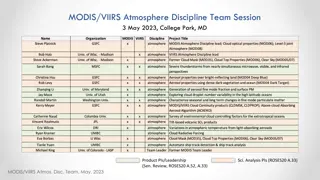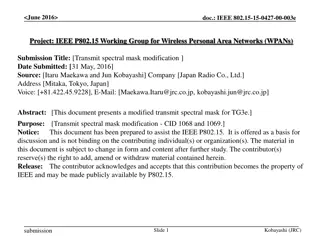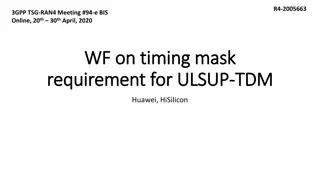VIIRS Cloud Mask (VCM) Provisional Status and Requirements
VIIRS Cloud Mask (VCM) is a critical tool for cloud cover determination, used in processing EDRs by classifying pixels as Clear, Cloudy, Probably Clear, or Probably Cloudy. VCM requirements detail criteria like Probability of Correct Typing, Cloud Leakage Rate, and False Alarm Rate. Definitions of these terms are key to interpreting VCM data. The Cal/Val approach involves NOAA leading product development, Aerospace validating, and Northrop Grumman supporting development.
Download Presentation

Please find below an Image/Link to download the presentation.
The content on the website is provided AS IS for your information and personal use only. It may not be sold, licensed, or shared on other websites without obtaining consent from the author.If you encounter any issues during the download, it is possible that the publisher has removed the file from their server.
You are allowed to download the files provided on this website for personal or commercial use, subject to the condition that they are used lawfully. All files are the property of their respective owners.
The content on the website is provided AS IS for your information and personal use only. It may not be sold, licensed, or shared on other websites without obtaining consent from the author.
E N D
Presentation Transcript
VIIRS Cloud Mask (VCM) Provisional Status Dr. Thomas Kopp VCM Validation Lead Dr. Andrew Heidinger Cloud Product Lead Dr. William Thomas VCM JAM 1
VCM Basics Fundamentally the VCM is a moderate band pixel-by-pixel determination of cloud cover As originally defined in the NPOESS system specification, it is used in the processing of many EDRs, which classifies pixels as Confidently Clear, Confidently Cloudy, Probably Clear, and Probably Cloudy The original requirements broke down the VCM performance into various backgrounds (e.g. day/night, ocean/land/desert) and characteristics (e.g. probability of correct typing, leakage, false alarms) The design of the VCM breaks down the cloud identification process by condition and background This logic has continued into the S-NPP and JPSS programs The applicable System Specification section, which fell under the Cloud Cover/Layers EDR, is shown on the following slide This is our target
VCM Requirements l. Binary Map HCS 0.8 km @ Nadir m. Binary Map Horizontal Reporting Interval Binary Map HCS n. Cloudy/Not Cloudy o. Binary Map Probability of Correct Typing 2. Ocean, Day, COT > 1.0 94% 4. Day, Land, COT > 1 90% 5. Ocean, Night, COT > 1 85% p. Cloud Leakage Rate 1. Ocean, Day, COT > 1.0, outside Sun Glint region 1% 2. Land, Day, COT > 1.0 3% 3. Land, Ocean, Night, COT > 1.0 5% q. False Alarm Rate 1. Ocean, Day, COT > 1.0 5% 2. Land, Day, ToC NDVI < 0.2 or ToC NDVI > 0.4, or Desert, COT > 1.0 7% 3. Land, Ocean, Night, COT > 1.0 8% r. Differentiate heavy aerosols from clouds, Day (0 < OD < 2), dust/sand, smoke, volcanic ash. 85% (SYS-TBR-002) s. Degraded Measurements Conditions 2. Cloud Leakage Rate a. Land, Ocean outside Sun Glint Region, Day, COT 1.0 5% c. Land, 0.2 ToC NDVI 0.4 and COT 1.0 7% d. Land and Ocean Sun Glint Regions 7% e. Night, Poleward of 60 deg N or 60 deg S 15% 3. False Alarm Rate a. Land, Ocean, Day, COT 1.0 8% c. Land, 0.2 ToC NDVI 0.4 and COT 1.0 10% d. Land and Ocean Sun Glint Regions 10% e. Night, Poleward of 60 deg N or 60 deg S 25%
Definitions Probability of Correct Typing: The percentage of confidently clear or confidently cloudy pixels that are properly identified as such Leakage: The percentage of pixels identified as confidently clear that in reality contain cloud False Alarms: The percentage of pixels identified as confidently cloudy that are in reality contain no clouds (they may contain aerosols)
VCM Cal/Val Approach The Cal/Val approach is basically a 3-legged pedestal with assistance from liaisons and program personnel NOAA leads product development and performs large scale analyses such as match-up comparisons Aerospace leads the validation effort and determines when and how threshold updates occur Northrop Grumman leads the development of Golden Granules and provides fundamental software support and development Other key contributors are our JPSS Algorithm Manager, Raytheon (COAST) representative, and our liaisons
VCM Cal/Val Core Team NESDIS/StAR - A. Heidinger (Product Lead and Cloud Liaison) The Aerospace Corporation - T. Kopp (Validation Lead) UW/CIMSS - R. Frey, D. Botambekov Northrop Grumman - K. Hutchison, B. Iisager NASA/DPE - B. Thomas (JAM) Raytheon K. Brueske (COAST) AFWA - J. Cetola NRL, Monterey - K. Richardson NESDIS/StAR - H. Cronk (Aerosol Liaison with L. Remer) UMBC - E. Vermote (Land Liaison) NRL, Stennis - D. May (Ocean Liaison)
VCM Inputs The VCM relies upon 12 of the 16 M-bands and 4 of the 5 I-bands for all of its computations The VCM can be tuned for known biases and noise It also depends upon ancillary data critical for accurate cloud identification Background surface temperatures at night (GFS) Water vapor content (GFS) Snow and ice NDVI
VIIRS Bands Used in the VCM Central Wavelength ( m) 0.412 0.445 0.488 0.555 0.672 0.746 0.865 1.240 1.378 1.61 2.25 3.7 4.05 8.55 10.763 12.013 Wavelength Range ( m) Spatial Resolution (m) @ nadir VIIRS Band Bandwidth ( m) Band Explanation M1 M2 0.02 0.018 0.02 0.02 0.02 0.015 0.039 0.02 0.015 0.06 0.05 0.0155 0.02 0.3 1.0 0.95 0.402 -0.422 0.436 - 0.454 0.478 - 0.488 0.545 -0.565 0.662 -0.682 0.739 - 0.754 0.846 -0.885 1.23 1.25 1.371 -1.386 1.58 1.64 2.23 - 2.28 3.61 3.79 3.97 4.13 8.4 -8.7 10.26 -11.26 11.54 -12.49 M3 (blue) M4 (green) M5 (red) M6 M7 M8 M9 M10 M11 M12 M13 M14 M15 M16 Visible Near IR 750 m Shortwave IR Medium-wave IR Longwave IR 750 m across full scan DNB 0.7 0.4 0.5 - 0.9 Visible I1 I2 I3 I4 I5 0.64 0.865 1.61 3.74 11.45 0.08 0.039 0.06 0.38 1.9 0.6 -0.68 0.85 0.88 1.58 - 1.64 3.55-3.93 10.5 12.4 Visible Near IR Shortwave IR Medium-wave IR Longwave IR 375 m Bands highlighted in pale yellow are used within the VCM 8
Status at Beta Beta was declared after the 30-day spin-up set of threshold adjustments were implemented on the IDPS 74 thresholds were adjusted during the 30 day spin up This implementation also opened up the VCM to analysis and critique by the other VIIRS EDR teams 1012 granules of VCM/MODIS/CALIPSO match-ups were produced for beta April 2012 Quantitative analysis shown on the next slide
Results Matching VCM and CALIPSO Global results (Beta stage) Cloud fraction Probability of Cloud Mask Sample Size Active Passive Pr. Clear Pr. Cloudy Detection False D. Leakage IDPS 88240 0.7513 0.6915 0.0920 0.0515 0.9012 0.0195 0.0793 SSEC Pre-tuned 85650 0.7555 0.7006 0.0971 0.0490 0.8994 0.0228 0.0777 SSEC Phase 2 85650 0.7555 0.6915 0.0638 0.0238 0.9063 0.0148 0.0789 NOAA PATMOS-x VIIRS 90358 0.7507 0.7122 0.0343 0.0348 0.9257 0.0179 0.0564 MODIS C6 272635 0.7217 0.7151 0.0808 0.0333 0.9407 0.0264 0.0329 NOAA PATMOS-x MODIS 272635 0.7217 0.6793 0.0321 0.0254 0.9446 0.0065 0.0489
Provisional Definition Product quality may not be optimal Optimal would be VCM attains all of its requirements Incremental product improvements still occurring DR history and future planned efforts will be shown Version control is in effect General research community is encouraged to participate VCM team set up liaisons even before launch Users urged to consult the EDR product status May be replaced in the archive Ready for operational evaluation This has already begun, hence the upcoming feedback from other VIIRS EDR teams
Product Quality Product quality was evaluated using three days of match- ups data between CALIPSO and the VCM over the month of November, and compared to results from May The latest threshold update was implemented early November Only one partial day was used for beta Results were executed twice, one for all clouds observed by CALIPSO and one with thin clouds removed Thin was defined as high cloud with an optical depth less than 0.3 Current analysis tool assumes a binary cloud mask Probably clear is counted as confidently clear, same for cloudy This penalizes the VCM, recall actual definitions of leakage/false alarms is based on confidently results only
Product Quality Global/All Clouds 90N 90S, Ocean/Land, Day/Night, No Snow/Snow/Ice CALIOP - VIIRS Matchup Pixels, 05/10/2012 CALIOP - VIIRS Matchup Pixels, 11/10/2012 Cloud fraction Probability of VIIRS Cloud Mask Sample Size Active Passive Pr. Clear Pr. Cloudy Detection False D. Leakage 257266 0.661 0.567 0.080 0.032 0.857 0.024 0.119 5/10/2012 304681 0.732 0.654 0.068 0.029 0.881 0.021 0.099 11/10/2012 13
Product Quality Global/No Thin 90N 90S, Ocean/Land, Day/Night, No Snow/Snow/Ice CALIOP - VIIRS Matchup Pixels, 05/10/2012 CALIOP - VIIRS Matchup Pixels, 11/10/2012 Cloud fraction Probability of VIIRS Cloud Mask Sample Size Active Passive Pr. Clear Pr. Cloudy Detection False D. Leakage 206367 0.618 0.586 0.087 0.028 0.892 0.038 0.070 5/10/2012 258832 0.698 0.667 0.069 0.025 0.906 0.032 0.063 11/10/2012 14
Product Quality No Polar 60N 60S, Ocean/Land, Day/Night, No Snow/No Ice CALIOP - VIIRS Matchup Pixels, 05/10/2012 CALIOP - VIIRS Matchup Pixels, 11/10/2012 Cloud fraction Probability of VIIRS Cloud Mask Sample Size Active Passive Pr. Clear Pr. Cloudy Detection False D. Leakage 218263 0.662 0.585 0.078 0.031 0.888 0.018 0.094 5/10/2012 237476 0.729 0.674 0.065 0.028 0.913 0.016 0.071 11/10/2012 15
Product Quality No Polar/No Thin 60N 60S, Ocean/Land, Day/Night, No Snow/No Ice CALIOP - VIIRS Matchup Pixels, 05/10/2012 CALIOP - VIIRS Matchup Pixels, 11/10/2012 Cloud fraction Probability of VIIRS Cloud Mask Sample Size Active Passive Pr. Clear Pr. Cloudy Detection False D. Leakage 178835 0.602 0.597 0.085 0.026 0.923 0.036 0.041 5/10/2012 203390 0.674 0.674 0.067 0.024 0.936 0.032 0.032 11/10/2012 16
Product Quality Ocean/Day 60N 60S, Ocean, Day, No Snow/No Ice CALIOP - VIIRS Matchup Pixels, 05/10/2012 CALIOP - VIIRS Matchup Pixels, 11/10/2012 Cloud fraction Probability of VIIRS Cloud Mask Sample Size Active Passive Pr. Clear Pr. Cloudy Detection False D. Leakage 71854 0.673 0.63 0.083 0.029 0.914 0.022 0.065 5/10/2012 79192 0.792 0.761 0.054 0.024 0.943 0.013 0.044 11/10/2012 17
Product Quality Ocean/Day/No Thin 60N 60S, Ocean, Day, No Snow/No Ice CALIOP - VIIRS Matchup Pixels, 05/10/2012 CALIOP - VIIRS Matchup Pixels, 11/10/2012 Cloud fraction Probability of VIIRS Cloud Mask Sample Size Active Passive Pr. Clear Pr. Cloudy Detection False D. Leakage 63078 0.581 0.606 0.110 0.026 0.930 0.048 0.023 5/10/2012 68544 0.732 0.750 0.068 0.020 0.953 0.032 0.014 11/10/2012 18
Product Quality Ocean/Night 60N 60S, Ocean, Night, No Snow/No Ice CALIOP - VIIRS Matchup Pixels, 05/10/2012 CALIOP - VIIRS Matchup Pixels, 11/10/2012 Cloud fraction Probability of VIIRS Cloud Mask Sample Size Active Passive Pr. Clear Pr. Cloudy Detection False D. Leakage 74826 0.801 0.719 0.087 0.043 0.887 0.016 0.098 5/10/2012 91334 0.815 0.743 0.073 0.042 0.906 0.011 0.083 11/10/2012 19
Product Quality Ocean/Night/No Thin 60N 60S, Ocean, Night, No Snow/No Ice CALIOP - VIIRS Matchup Pixels, 05/10/2012 CALIOP - VIIRS Matchup Pixels, 11/10/2012 Cloud fraction Probability of VIIRS Cloud Mask Sample Size Active Passive Pr. Clear Pr. Cloudy Detection False D. Leakage 61716 0.701 0.716 0.085 0.034 0.932 0.041 0.027 5/10/2012 80132 0.713 0.722 0.074 0.036 0.938 0.036 0.026 11/10/2012 20
Product Quality Land/Day 60N 60S, Land, Day, No Snow/No Ice CALIOP - VIIRS Matchup Pixels, 05/10/2012 CALIOP - VIIRS Matchup Pixels, 11/10/2012 Cloud fraction Probability of VIIRS Cloud Mask Sample Size Active Passive Pr. Clear Pr. Cloudy Detection False D. Leakage 34669 0.408 0.338 0.054 0.011 0.893 0.019 0.089 5/10/2012 11/10/2012 36049 0.534 0.498 0.077 0.008 0.886 0.039 0.075 21
Product Quality Land/Day/No Thin 60N 60S, Land, Day, No Snow/No Ice CALIOP - VIIRS Matchup Pixels, 05/10/2012 CALIOP - VIIRS Matchup Pixels, 11/10/2012 Cloud fraction Probability of VIIRS Cloud Mask Sample Size Active Passive Pr. Clear Pr. Cloudy Detection False D. Leakage 28423 0.413 0.356 0.053 0.010 0.903 0.021 0.077 5/10/2012 11/10/2012 29945 0.562 0.531 0.061 0.007 0.894 0.038 0.068 22
Product Quality Land/Night 60N 60S, Land, Night, No Snow/No Ice CALIOP - VIIRS Matchup Pixels, 05/10/2012 CALIOP - VIIRS Matchup Pixels, 11/10/2012 Cloud fraction Probability of VIIRS Cloud Mask Sample Size Active Passive Pr. Clear Pr. Cloudy Detection False D. Leakage 23315 0.558 0.392 0.063 0.021 0.818 0.008 0.174 5/10/2012 17040 0.422 0.326 0.050 0.014 0.881 0.012 0.108 11/10/2012 23
Product Quality Land/Night/No Thin 60N 60S, Land, Night, No Snow/No Ice CALIOP - VIIRS Matchup Pixels, 05/10/2012 CALIOP - VIIRS Matchup Pixels, 11/10/2012 Cloud fraction Probability of VIIRS Cloud Mask Sample Size Active Passive Pr. Clear Pr. Cloudy Detection False D. Leakage 15464 0.597 0.507 0.055 0.020 0.903 0.004 0.093 5/10/2012 13429 0.412 0.345 0.051 0.012 0.925 0.004 0.071 11/10/2012 24
Product Quality Polar/NH 60N 90N, All CALIOP - VIIRS Matchup Pixels, 05/10/2012 CALIOP - VIIRS Matchup Pixels, 11/10/2012 Cloud fraction Probability of VIIRS Cloud Mask Sample Size Active Passive Pr. Clear Pr. Cloudy Detection False D. Leakage 13438 0.643 0.388 0.073 0.037 0.724 0.010 0.265 5/10/2012 13693 0.788 0.420 0.164 0.066 0.604 0.014 0.382 11/10/2012 25
Product Quality Polar/SH 60S 90S, All CALIOP - VIIRS Matchup Pixels, 05/10/2012 CALIOP - VIIRS Matchup Pixels, 11/10/2012 Cloud fraction Probability of VIIRS Cloud Mask Sample Size Active Passive Pr. Clear Pr. Cloudy Detection False D. Leakage 12564 0.537 0.360 0.121 0.051 0.503 0.160 0.334 5/10/2012 22061 0.549 0.558 0.039 0.021 0.795 0.092 0.113 11/10/2012 26
Product Quality Summary Global results show improvement for all evaluation criteria for the VCM Outside of the polar regions, both probability of detection and false alarms are near, if not at, requirements Leakage percentages are down 25-50% from May However values still exceed requirements across the board Serious concerns exist to the results in polar locations Daytime shows improvement but unquestionably short of requirements Polar night is missing too many clouds Note the requirements expected this
Incremental Product Improvement The VCM has had three software updates and three threshold updates since the declaration of beta Software upgrades targeted shortfalls in the visual cloud detection test and consideration of scattering angles Threshold updates aimed primarily at reducing leakage Seven Discrepancy Reports related to the VCM have been closed since the declaration of beta Longer term fixes for aerosol/cloud differentiation and high cloud identification over snow/desert in work for a February delivery
Incremental Product Improvement DRs considered critical at this time are: DR 5039 Water vapor consideration for M9 Software delivery scheduled for late February DR 5038 Cloud/Dust discrimination Software delivery scheduled for late February DR 4998 Leakage feedback from Cal/Val teams Ongoing but first threshold update directly addressing this DR approved by the AERB January 9 DR 4734 Correct volcanic ash threshold Feedback from aerosol and cloud teams indicate logic should be updated DR 4577 Cloud/snow discrimination in the VCM Resolved over non-polar open water backgrounds but work continues on land and polar regions
Incremental Product Improvement The VCM team has developed a list of activities either in progress or to be worked as priorities and resources allow Threshold updates NDVI impacts after gridding implementation, cloud phase, additional leakage issues, aerosol parameters Software/code improvements Low-light specific algorithms, cirrus logic expansion, snow/ice/cloud differentiation, Antarctica Ongoing validation efforts Additional Golden Granules, continued match-up analysis, ADA/ADL upgrades, continual presentation needs (AERB, conferences, TIMs) This list is updated monthly
Version Control All key documents are up-to-date ATBD, OAD, CDFCB-X all match operational VCM as of today Note the VCM team uses configuration management of the associated Processing Coefficient Tables XML files to maintain an up-to-date historical record of threshold changes No document is expected to contain current operational values for all PCT thresholds Upcoming code deliveries will require updates to all three documents noted above
Community Interaction Many items, be they threshold or software updates, are now driven by feedback from other Cal/Val teams Consistent contact is maintained with all liaisons and others who have the capability to observe VCM impacts on their products All threshold updates are now initiated either after specific feedback from a VIIRS Cal/Val team or after we have analyzed granules where issues have been identified Two examples follow We will continue to use liaisons to communicate across the different Cal/Val teams The VCM telecom, which generally meets bi-weekly, is open to anyone interested
Community Interaction Regional SST biases from NAVO
Community Interaction Aerosol/VCM displays from the aerosol team
Users and Product Status Bi-weekly telecoms are used, in part, to maintain open communication for both internal and external (liaison) VCM members with ongoing work and implementation dates Actual dates when thresholds are updated could be communicated better No one on the VCM team receives notices when thresholds are actually placed on the system Added member from Raytheon has improved this
Users and Product Status Five caveats may be found in the VCM Read Me file at the time beta was declared Dependency on two external fields (snow and NDVI) that were fixed values from 2002 Snow now being updated monthly NDVI no longer a fixed field, updates occurring but no known schedule as to how often Difficulties differentiating low clouds from snow/ice Resolved over open water away from polar regions, otherwise still present, as already discussed Leakage, also already discussed Results near edge-of-scan Resolved with implementation of scattering angle curves VCM performance at night over land/snow/ice Improving over land, an open issue over snow/ice
Archive of the VCM The VCM, although it is considered an Intermediate Product (IP), is archived by CLASS There are no plans the VCM team is aware of to reproduce and replace what is in the archive Most downstream users, when reproducing products on a large scale, include the VCM as part of the software executed and not as an input The VCM team does not currently have any plans to reproduce the VCM in the archive
Ready for Operational Evaluation The VCM, as indicated by the feedback already received, has been evaluated by users for the past few months It had always been the intent, which has been met, that the VCM would be ready for outside evaluation after the 30-day spin-up (beta stage) The fact that this TIM includes presentations from downstream EDRs indicates this analysis has already been ongoing for months Even the climate community has already started to look at the VCM output
Ready for Operational Evaluation Chart showing VCM output with CALIOP over all latitude bands alongside MODIS results
Ready for Operational Evaluation Proposed caveats for the VCM at the provisional stage are: External fields of snow and NDVI not updating at expected frequencies, older backgrounds will introduce additional errors Nighttime performance above snow/ice backgrounds suspect Leakage should be monitored and we ask significant areas be reported (widespread occurrences should be isolated) All users should exploit available quality flags present in the VCM but not being used as they should Snow/ice bit, thin cirrus bit, quality bit
Path Forward Primary function of the validation team in the next few months is twofold Reduce leakage further Address the cloud mask over snow/ice Evaluate additional Golden Granules to cover relevant scenes and backgrounds Pursue quantitative validation of cloud phase and aerosol quality flags Continue to interact and be responsive to other VIIRS EDR team needs
Conclusion VCM has shown marked improvement over the last few months Probability of Correct Typing and False Alarms at or better than requirements Leakage numbers are down but trend must continue Polar regions need work The VCM has met all provisional criteria Feedback from other VIIRS EDR teams and liaisons has been occurring since beta And you will see some of this shortly Documentation up-to-date
